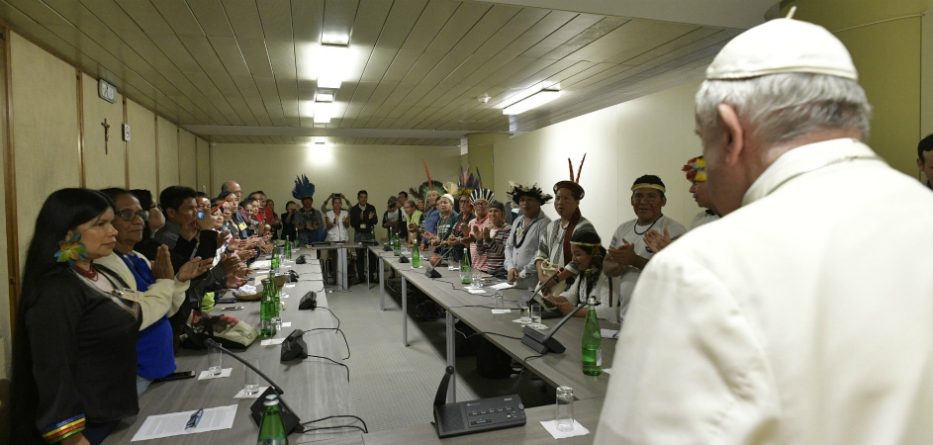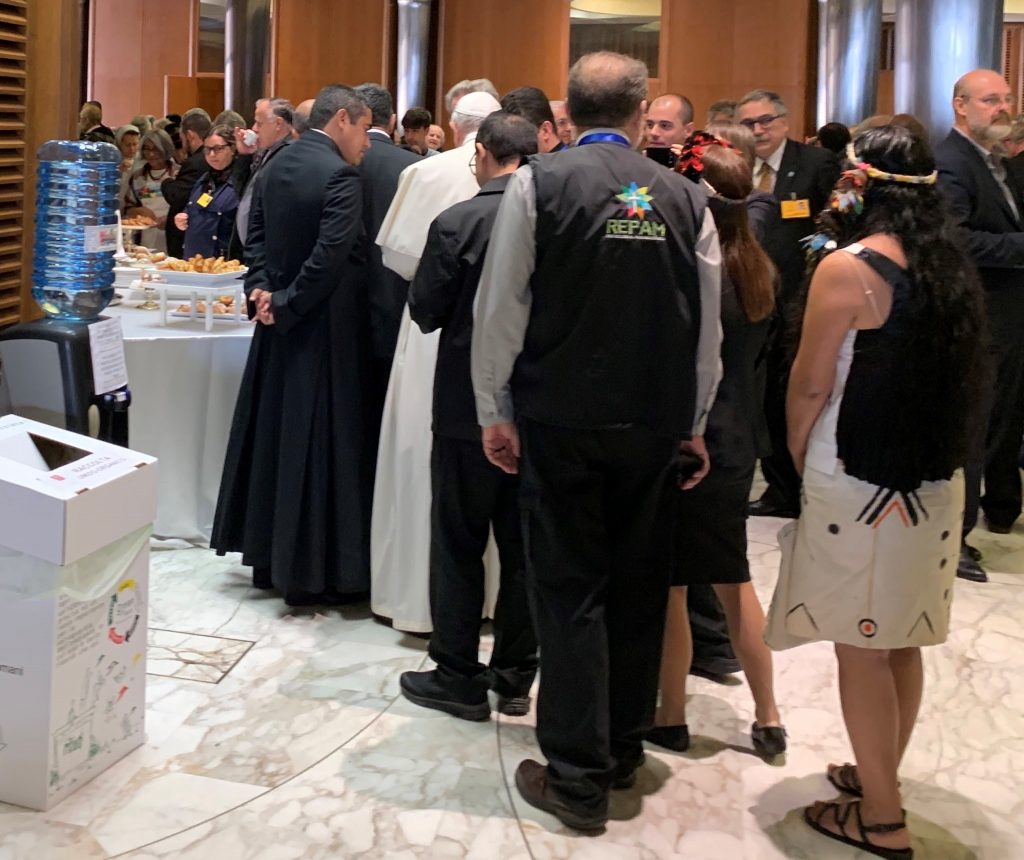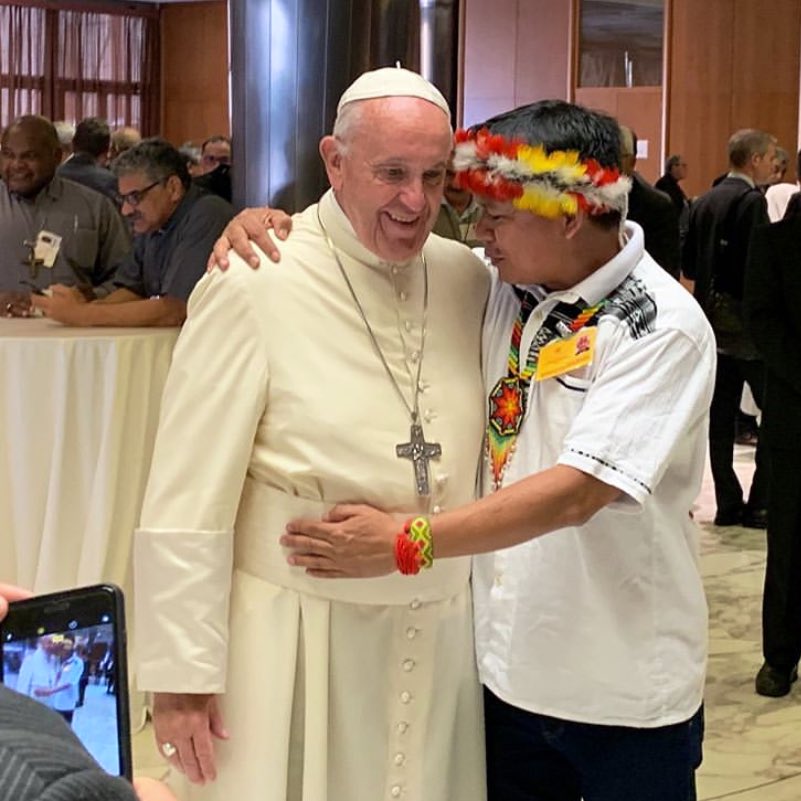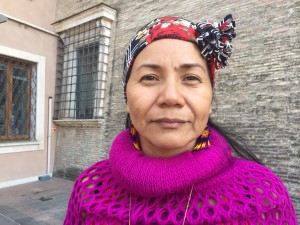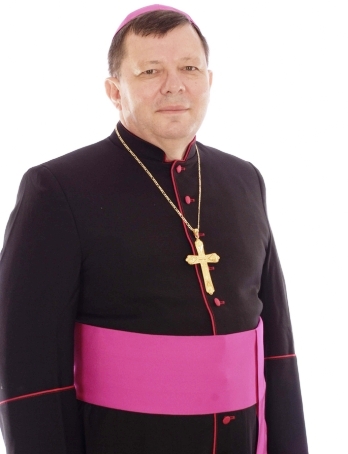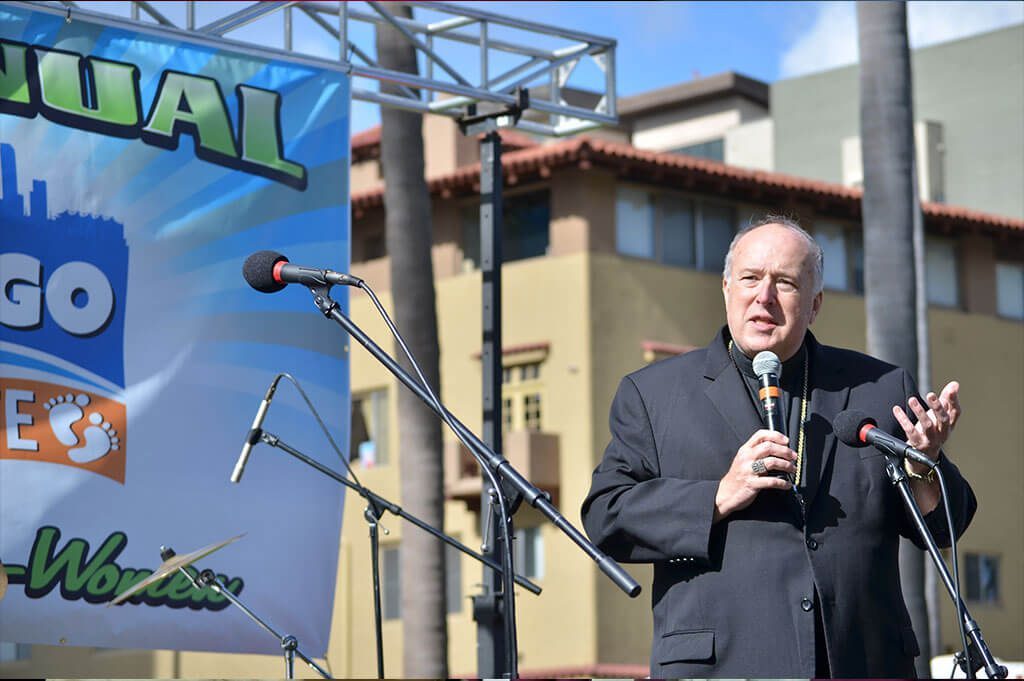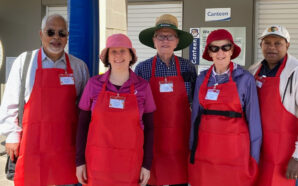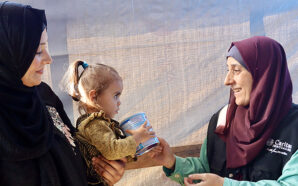Letters from the Synod is written by Br Mark O’Connor FMS.
Currently in Rome for the Synod of Bishops for the Pan-Amazon Region, Br Mark will be providing regular updates and news from the Synod.
Letter Number Four.
“Following the Spirit means following the pain-lines to join the powerless in the Spirit’s creative and redemptive work”
Fr Enda McDonagh
Dear Friends,
The Spirit is leading Pope Francis and the Synod of Bishops for the Pan-Amazon Region to follow the “pain-lines” of the local Churches of the Amazonian region and to join the powerless.
That has enormous significance for them and also for the entire Universal Church.
And so, after two intense weeks of hundreds of speeches and many hours of dialogue and discussion the Synod of Bishops for the Pan-Amazon Region now enters into a new phase.
A summary of the reports from the all-important small discussion groups will be issued literally in the next few hours.
Then the final phase of preparing a final message begins.
However, what I can now simply share with you – with my ‘ear to the ground’ – are some further personal reflections from my time here at the Synod listening and learning, with so many others of the Pilgrim People of God.
Remember, this is primarily a Synod of Bishops and it is of course, not a parliament. So, it hands over all its deliberations to Pope Francis who, as ‘Peter’, will make all the final decisions.
But many delegates that I have spoken to say that there are two things that particularly strike them about these days of grace.
The first is how many people comment about the humble listening presence of Pope Francis at the Synod.
Pope Francis mainly just listens and in the simple interactions, at moments like coffee breaks, just joins the queue and is himself a participant keen to share and learn.
The second is how the Synod Hall is often filled with a touching reverence and silence after the witness of the Indigenous peoples – women, and men – who are present in significant numbers.
Their participation is the highlight of the Synod to so many.
One North American Bishop told me the Indigenous Amazonian voices and the stories of their suffering were heart-rending.
When they spoke, so poignantly and authentically of the trust and hope they have in the Church to assist them, they received the loudest applause.
So did the many laypeople, especially the women who gave testimony.
This bishop dryly also noted that when many bishops spoke there was a tendency to doze off!
When one truly listens to such people sharing their pain, ‘conversion’ and the Good News of Jesus of Nazareth become real.
Or one can close one’s heart and become locked and isolated in rigid ideologies. The choice is ours.
To help you in your prayer and further reflection, I cannot recommend highly enough, Antonio Spadaro SJ and Mauricio Lopez Oropeza’s just-published article.
It is a brilliant analysis of the kind of ‘conversion’ this Synod is demanding of all of us.
An excellent summary of the first two weeks is also provided us by Luke Hansen SJ.
So, let’s now listen to some of the ‘pain-lines’ of the Indigenous peoples of the Amazon region.
The ‘pain-lines’ of the Amazon
I can only highlight just a few voices and their moving testimonies about the suffering of these local Churches. These good people face:
Extreme violence done to Indigenous peoples
Anitalia Pijachi, an Indigenous woman from the Amazonian town of Leticia, Colombia, came to the Synod of Bishops for the Amazon bringing a message from the elders of her people to Pope Francis, an elder of the Catholic Church.
The first Europeans to arrive in the Amazon were “invaders,” she said.
“They never asked permission of Mother Nature or of the people who lived there. They imposed the cross and the Bible. That caused a great deal of resentment,” and in some cases forced Indigenous peoples from their territories.
The numbers of Indigenous people slaughtered and also killed by new diseases brought by the Spanish and Portuguese colonisers is simply staggering. It was a genocide of extreme proportions.
But however, when the Pope, during his 2018 visit to Peru, asked Amazonian people to tell the Church how it should walk with them, “that was a question that asked permission.”
Ongoing ecological destruction
Many Synod participants reminded us that the Creator entrusted the Amazon to our care. As outlined at the Synod, “It is the most beautiful and vital garden on the planet”.
But unfortunately, we risk transforming this “terrestrial paradise” into a “hell” because of the fires raging which could deprive certain Indigenous peoples of their indispensable heritage.
Walking together means listening to “the agony of Mother Earth” and becoming aware of the “violence behind extractive ethnocide”.
The appeal made by Indigenous Amazonian organisations is that of reversing the tide so as not to fall into greater danger.
Evil drug trafficking
Bishop Del Rio recounted how the drug trade affects the Indigenous people, by describing the situation in Colombia, where he is Apostolic Vicar of Mitù.
Despite the peace process, it is a violent area where guerrilla fighters hide and where illegal crops are grown, he said.
Once he saw four or five planes taking off, all of them filled with drugs. Young people try to become members of those groups because of the easy money they promise.
One community started changing their way of life, said the Bishop, by updating their forms of food. Many Indigenous peoples have left to find a “better” life and never return, said Bishop Del Rio.
Shocking violence against women
Sister Echeverri spoke to the question about violence against women, saying “the Synod speaks to everyone”.
What happens in the Amazon happens everywhere, she said, including violence against women.
She mentioned human trafficking, in particular, saying it is connected to migration and sexual exploitation.
Sister Echeverri also spoke of women being denied the right or possibility to study. She mentioned how women religious who have served the Indigenous peoples have been murdered. These martyrs have made the Amazonian land fruitful, she added.
“Following the Spirit means following the pain-lines to join the powerless in the Spirit’s creative and redemptive work.”
Other strong themes that emerged, were the importance of being attentive to the dignity of workers, and to the question of youth unemployment.
There are new forms of slavery everywhere in the Amazonian region that must be confronted, forced employment, prostitution, and organ trafficking must be addressed in a prophetic way.
So much pain and suffering! So much injustice.
One Sister stressed how we all need to listen to the voice of God, the poor, creation, and the earth, that is coming to us from the Amazon. We must also be ready to acknowledge both our successes and our failures.
Patricia Gualinga: We fight for the care of our common home. We are counting on our alliance with the Church for the defense of our lands. #17October #AmazonSynod Briefing @HolySeePress pic.twitter.com/V11LiMKArM
— Vatican News (@VaticanNews) October 17, 2019
How then can we as Church follow the ‘pain-lines’ and be in solidarity with these suffering peoples?
The following ‘snapshots’ are how some voices from the Amazonian Synod envisage it.
PASTORAL WAYS FORWARD: Toward an Amazonian Church with an Indigenous face
Many times, the request was heard in the Synod Hall to be constantly aware of the suffering of the Indigenous population, who have a sovereign right to exist in the Amazon.
Discovering the seeds of the word of God in the cultures and traditions of the region means recognising that Christ already lives in the peoples who have not yet heard the Gospel.
The Gospel, in fact, is not the exclusive patrimony of any one culture.
It is this approach that favours the existence of an Indigenous and Amazonian Church, one person said.
One proposal is that a new regional structure is instituted which would continue the momentum created by the positive experience of the networks created in the pre-Synod process and the inspirations of the Spirit received during the Synod.
One bishop spoke powerfully about the need to intensify the Indigenous pastoral ministry. He spoke of how the local Church is putting into practice “what the Pope is calling us to do”: namely, that it should be the Indigenous peoples themselves who shape the Church in the Amazon.
An important aspect, said Bishop Wilmar, is that the people he works with should have their own leaders. Until now, these have always been foreigners.
Pope Francis, said Bishop Wilmar, told someone how he dreamed of seeing an Indigenous priest in every village.
When Bishop Wilmar asked how to fulfil that dream, the Pope said he should start with what the Church already allows: the permanent diaconate. Which is what they decided to do.
Many bishops spoke powerfully of the importance of a new type of formation that forms ministers to baptise and later to witness marriages.
The local Indigenous people give great importance to the Sacrament of Baptism and they want to be married in the Church. They desire God’s blessings.
Which is why there must be ministers to perform baptisms and marriages in every village. This will help the people very much.
Others voiced the strong view that the traditional Tridentine seminary is no longer sufficient. Their local Churches need priests who come out of the communities.
The People of God need a theology that speaks to people of the presence of God and shows that presence.
Carlo Verzeletti, a Brazilian bishop in Amazon, told the Synod that it’s vital to ordain married men, “so we can be closer to the people”.
His diocese already has “extraordinary” married men who are already living “Eucharistic” lives, that is, selflessly serving others, and serving the common good.
One Synodal delegate movingly described the precious contribution of itinerant missionary teams inspired by Jesus who visited village after village without stopping, without even having a place to stay.
This provides a model for the Church always “on the move”, leaving behind a pastoral ministry meant to preserve the past to one that is creative.
Certain structures, it was noted, are already obsolete and are in desperate need of updating. We can no longer be obsolete while the rest of the world moves ahead.
The Gospel, in fact, always has something new to say. This, too, is a part of the ecological conversion.
Openness to new forms of ministry means the incorporation of women and young people.
The theme of women in the Church was also brought up again and again, with the request that they are given more pastoral responsibility and effective participation, even at decision-making levels.
Discerning the institution of women deacons in the region was also requested.
Women today have already acquired greater roles in the life of the Christian community, not only as catechists or mothers but also as persons capable of taking on new ministries.
In addition, it was proposed that the inclusion of women, under the sign of reconciliation of the covenant, could lay the foundation for a less clerical Church. Clericalism is still present in the Church today, one Synod participant emphatically stated, and is an obstacle to service, fraternity, and solidarity.
I wonder aloud whether some of these Amazonian questions and their attempts to follow their ‘pain-lines’ in the power of the Spirit are also relevant to our church in Australia?
Many of the questions they are asking are very much heard in the Australian Church also.
A SAD FOOTNOTE: Shameful resistance to taking the pain of others seriously
Amongst all this wonderful Gospel pastoral creativity responding to the ‘pain-lines’, there continues to be present at the Synod, the destructive behaviour of certain Canadian and USA reactionary, that is, so-called ‘Catholic’ media outlets (as I mentioned in my third letter.)
Their inability to empathise with the Indigenous peoples of the Amazon exhibits a callous lack of humanity – let alone their failure to even to begin to understand the Gospel of Jesus of Nazareth.
Although they speak for few, they are well resourced by powerful interests who oppose Pope Francis.
Much of their absurd agitprop has been focused on the ceremony in the Vatican Gardens organised by the Franciscans.
A small statue of a woman was on display. Some of the Indigenous call her “Our Lady of the Amazon” but whatever of that, it doesn’t stop these people denouncing the influence of ‘paganism’!
Not a single empathetic story have they printed about the suffering of these Amazonian Indigenous peoples. A total disgrace…
Observing them trying to make their ludicrous connections with what they clearly see as ‘fertility’ and/or sexual themes, makes one wonder what Dr Freud would make of their antics!
And as for their obsessions with “paganism”, they seem not to have observed Churches which are on every corner in the historic centre of Rome – where previous Christians (especially Popes) have put a cross on every Greek and Roman “pagan” temple in the city!
It’s amazing they don’t seem to have ever visited the Pantheon and understood its history!
Nor read the newly-canonised St John Henry Newman who reminded Christians in the 19th Century to approach other cultures, even if they are non-Christian, with humility. In his 1878 Essay on the Development of Christian Doctrine, he noted that the Church has always adopted pagan elements in its traditions and especially its liturgical rites:
“The use of temples, and these dedicated to particular saints, and ornamented on occasions with branches of trees, incense, lamps and candles; votive offerings on recovery from illness; holy water, asylums; holy days and seasons, use of calendars, processions, blessings on the fields, sacerdotal vestments, the tonsure, the ring in marriage, turning to the east, images at a later date, perhaps the ecclesiastical chant, and the Kyrie Eleison, are all of pagan origin, and sanctified by their adoption into the church.”
If you want to expose idolatry at the synod, suggest you go talk to some multinationals ripping up the rainforest & destroying cultures for $$$$ and ask them what they worship. #SinodoAmazonico https://t.co/uzN8IDpMU3
— Austen Ivereigh (@austeni) October 16, 2019
In any case, as Austen Ivereigh has so wisely pointed out, their repeated nasty attempts to demonise the native culture of the Amazon remains the real scandal of the Synod.
And as he so acutely retorted back to them: “If you want to expose idolatry at the Synod, I suggest you go talk to some multinationals ripping up the rainforest & destroying cultures for $$$$ and ask them what they worship.”
CONCLUSION: Following the Church in Australia’s ‘pain- lines’ to join the powerless in the Spirit’s creative and redemptive work
So, what might all this mean for our own Church in Australia – especially the upcoming Plenary Council in Adelaide in 2020?
A few purely personal thoughts occur to me after these last two weeks.
Surely, a key question that we, Australian Catholics, must continue to address is:
What are our ‘pain-lines’? How can we join the powerless in the Spirit’s creative and redemptive work?
All of us know of the perilous condition of contemporary Catholicism in post-Royal Commission Australia.
As Catholics, we all want to take the Gospel message out into contemporary Australian society. That is a key hope for our Plenary Council.
But we must not be blind to a searing ‘pain-line’ devastating our Church like a bush fire.
There is great discontent about the sins and failures of our Church in recent times. The pain is so intense one almost finds it impossible to discuss matters of faith. The anger and alienation are too raw.
For me, in all honesty, unless we follow the ‘pain-lines’ this means a simple truth. Evangelisation in Australia will be paralysed for generations to come.
If we go forward, as a Church, after the Plenary Council process, believing we already know beforehand how to ‘answer people’ and are not really interested in their questions, then evangelisation becomes an empty slogan and a meaningless ‘battle cry’.
Worse, the Church in Australia is then destined to become an irrelevant sect with its leaders ‘putting the wagons in a circle’ and in constant ‘defensive’ mode.
Certainly, we must not avoid issues related to Church governance.
After the Royal Commission, it is screamingly obvious that we need to reimagine a different authority/power structure in the Church.
Canon Law is not frozen, and it can and has been developed many, many times in the history of the Church.
This can be a legitimate development in the spirit of St John Henry Newman and thoroughly compatible with orthodoxy.
We need a new division of power – concretely a new relationship between lay people and priests, between full-time and volunteers, between men and women in the Catholic Church.
We need a leadership that is willing to give up power in favour of new structures. The Church is definitely not a democracy. But neither is it a dictatorship – even a benevolent dictatorship.
We must have a future Catholic leadership that is wholeheartedly willing to submit itself to structures in which the laity have greater decision-making power.
All of this is merely fulfilling the call and vision of our own Pope Francis.
Our future as a Church is not one of prohibitions and commandments, but a Church that lives in relationship with people and in relationship with Jesus Christ. That is the bottom line.
Our Plenary Council must not, however, degenerate into ‘navel gazing’ only concerned about internal church matters. We are, after all, a mission that has a Church!
We must, therefore, continue to become more Kingdom of God centred.
If the Amazon Synod has taught me anything it is this: we need, as an Australian Church, to really take seriously Pope Francis’s call for ecological conversion in Laudato Si.
Particularly helpful, in this regard, is the recent speech of Bishop Bob McElroy of San Diego.
As one of the few USA Bishops appointed by Pope Francis to the Synod, Bob Mc Elroy’s words resonated in my heart as an Australian Catholic.
Such good living also “rejects grave disparities of wealth and social inequality,” he said. “It breathes with the spirit of God.”
Bishop Bob acknowledged that “the specific form of good living that exists for the Indigenous peoples of the Amazon will not be transferable to most other cultures in the world.”
But he does believe that, “its underlying themes of connectedness, moderation, balance and sharing must become the norm for all peoples in re-evaluating our lifestyles if we are to escape the lures of materialism and build a sustainable society for our world”.
My next and final letter will consider the final message of this great Synod of the Amazon.
Until then, I think we can all learn much by praying and reflecting on the prophetic words of Fr Enda McDonagh, “Following the Spirit means following the ‘pain-lines’ to join the powerless in the Spirit’s creative and redemptive work.”
Follow the pain-lines…
Br Mark O’Connor FMS is the Vicar for Communications in the Diocese of Parramatta and the Pope Francis Fellow, Newman College, University of Melbourne.
The Special Assembly of the Synod of Bishops for the Pan-Amazon Region will be held in the Vatican from 6 to 27 October. For more information, click here.




